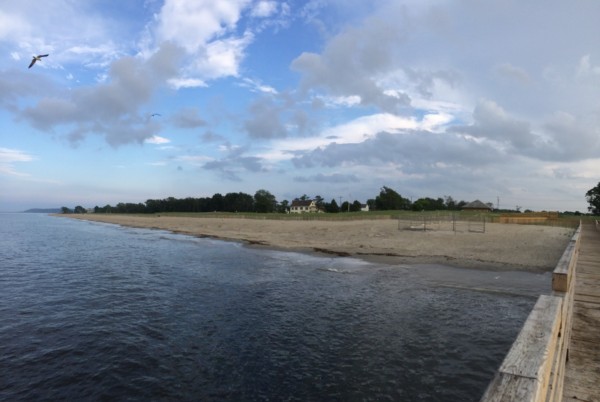On the News: Will new flood protections guard Port Monmouth?

The Army Corps of Engineers completed work on the first phase of a $105 million storm resiliency and flood mitigation project in the Port Monmouth section of Middletown Township, according to a report in the Asbury Park Press. But the project will present new challenges, according to a New Jersey Sea Grant Consortium and Monmouth University expert.
The $17.7 million first phase was reportedly in development for years before the storm, but the damage sustained to the small bayside community in the aftermath of the tempest made completion of the project a priority.
Port Monmouth is a small peninsula. To the north of the 3,800-person community is Sandy Hook Bay, to the west and east are Pews and Compton creeks and their respective salt marshes. The Superstorm Sandy surge and tidal flooding reportedly damaged 750 homes. The community had 1,441 housing units, according to the 2010 census.
“Being that the project was in the pipeline for the past couple of decades, it can be seen as a worthwhile venture,” said Dr. Michael Schwebel, reacting to the report. “It is well-rounded and holistic in that it will address the Sandy Hook Bay and back creek flooding through tide gates, levees, and water pumping stations.”
Schwebel is the community resilience and climate adaptation specialist for NJSGC and Monmouth University’s Urban Coast Institute.
In the first phase, sand dunes were built 13 feet above sea level to provide storm surge protection, 400,000 cubic yards of sand was placed along Monmouth County’s Bayshore Waterfront Park and a stone groin that extends 300 feet into Sandy Hook Bay was built. Additionally, the Port Monmouth fishing pier was extended 195 feet into the bay.
Related: NJSGC Dune It Right Manual is a guide to dune restoration: click here.
“These are the types of projects that will help alleviate some of the flooding, surge, and overall impact of storm events and impacts of sea-level rise,” Schwebel said. “However, like the article stated, this is only Phase 1. This project is only focused on water coming in from Sandy Hook Bay and the future phases will help to solidify the resilience of Port Monmouth.”
The second phase of the project includes a system of levees, a flood wall, a tide gate, road closure structures and pumping stations. Construction is expected to be completed in 2019. This second phase is expected to transform the look and feel of the community, township Administrator Anthony Mercantante told the Asbury Park Press.
“It appears that Port Monmouth, if all of these to-be-built features are implemented, will be well-situated to withstand some of the future storm events and impacts of forecasted climate change, Schwebel said. “It is impossible to plan for all storms, situations and scenarios and it is also not financially feasible to do so.”
New Jersey’s intense development along the coast presents unique challenges for coastal flooding and storm protection, Schwebel said. New Jersey is fractured by many small jurisdictional lines —small towns packed next to each other all with different policies, implementation and politics.
“If one community or town implements these resilient methods, but an adjoining area does not, that can lead to susceptibility and flooding since levees, walls, and other structures eventually have a terminus,” Schwebel cautioned. “A piecemeal effort results in piecemeal benefits.”
Indeed, the Port Monmouth project abuts an older flood control system that was completed in 1973, which was designed to protect the Borough of Keansburg and the North Middletown section of Middletown Township. The levees, built in response to storms in the 1960s, failed during Sandy and the Raritan and Sandy Hook bays rushed into the community. The Army Corps will spend more than $40 million to repair and reinforce that project, according to a NJ.com report.
“It’s important to remember that nothing will stop 100% of flooding, but there are strategies that municipalities and residents can take to lessen the impact of these events and increase their capacity to respond in a more resilient manner,” Schwebel said. “If more communities or neighborhoods followed this model, the Jersey Shore would be a more resilient place.”